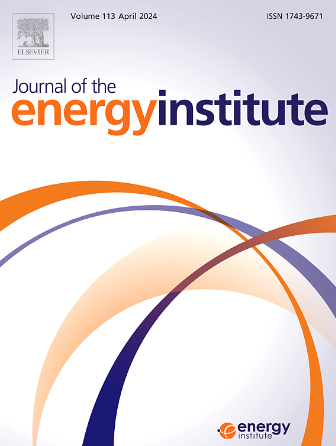Multi-algorithm synergy in biomass pyrolysis via TG-FTIR-GC/MS: kinetic triplet resolution with particle swarm optimization (PSO) and the specific product evolution
IF 5.6
2区 工程技术
Q2 ENERGY & FUELS
引用次数: 0
Abstract
This study presents a comprehensive kinetic analysis of biomass thermal decomposition by integrating particle swarm optimization (PSO) with TG-FTIR-GC/MS hyphenated techniques. Systematic pyrolysis of wheat straw (WS) and pine sawdust (PS) under varied heating rates revealed feedstock-specific decomposition mechanisms. Model-free kinetic analysis demonstrated distinct activation energies (PS: 158.2 kJ/mol; WS: 147.3 kJ/mol), reflecting lignocellulosic divergence. Crucially, a PSO-optimized parallel reaction model resolved kinetic triplets with exceptional accuracy (R2 > 0.99), identifying cellulose-dominated degradation in PS versus hemicellulose-driven decomposition in WS. Volatile evolution analysis decoupled temperature-dependent product profiles: PS generated aromatic compounds at high temperatures, while WS favoured furans and phenolics. By integrating multi-scale pyrolysis kinetics and volatile chemistry, this work establishes a novel framework for targeted biomass valorization via algorithmic optimization and multi-technique synergy.

TG-FTIR-GC/MS生物质热解多算法协同:基于粒子群优化(PSO)的动力学三重态解析和特定产物演化
本文将粒子群优化(PSO)与TG-FTIR-GC/MS联用技术相结合,对生物质热分解过程进行了动力学分析。小麦秸秆(WS)和松木屑(PS)在不同升温速率下的系统热解揭示了原料特有的分解机制。无模型动力学分析显示不同的活化能(PS: 158.2 kJ/mol;WS: 147.3 kJ/mol),反映了木质纤维素的分化。最重要的是,pso优化的平行反应模型以优异的精度(R2 >;0.99),鉴定了PS中纤维素主导的降解与WS中半纤维素驱动的分解。挥发性演化分析解耦了温度依赖性产物谱:PS在高温下生成芳香族化合物,而WS在高温下生成呋喃和酚类化合物。通过整合多尺度热解动力学和挥发化学,本工作通过算法优化和多技术协同建立了一个新的生物质定向增值框架。
本文章由计算机程序翻译,如有差异,请以英文原文为准。
求助全文
约1分钟内获得全文
求助全文
来源期刊

Journal of The Energy Institute
工程技术-能源与燃料
CiteScore
10.60
自引率
5.30%
发文量
166
审稿时长
16 days
期刊介绍:
The Journal of the Energy Institute provides peer reviewed coverage of original high quality research on energy, engineering and technology.The coverage is broad and the main areas of interest include:
Combustion engineering and associated technologies; process heating; power generation; engines and propulsion; emissions and environmental pollution control; clean coal technologies; carbon abatement technologies
Emissions and environmental pollution control; safety and hazards;
Clean coal technologies; carbon abatement technologies, including carbon capture and storage, CCS;
Petroleum engineering and fuel quality, including storage and transport
Alternative energy sources; biomass utilisation and biomass conversion technologies; energy from waste, incineration and recycling
Energy conversion, energy recovery and energy efficiency; space heating, fuel cells, heat pumps and cooling systems
Energy storage
The journal''s coverage reflects changes in energy technology that result from the transition to more efficient energy production and end use together with reduced carbon emission.
 求助内容:
求助内容: 应助结果提醒方式:
应助结果提醒方式:


